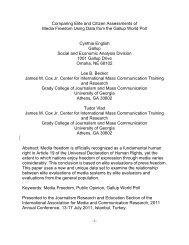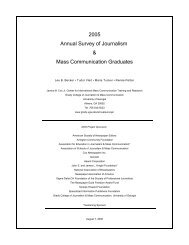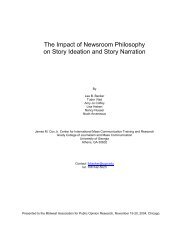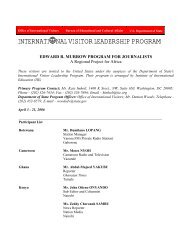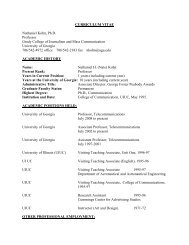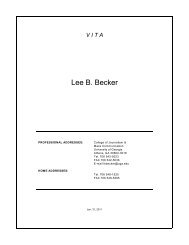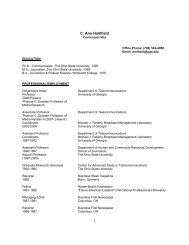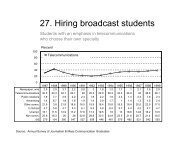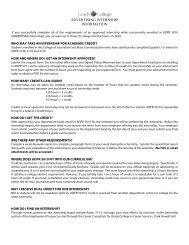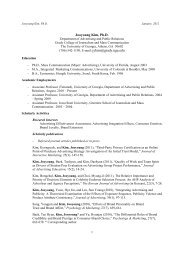Professionalism of News Workers - Grady College of Journalism and ...
Professionalism of News Workers - Grady College of Journalism and ...
Professionalism of News Workers - Grady College of Journalism and ...
Create successful ePaper yourself
Turn your PDF publications into a flip-book with our unique Google optimized e-Paper software.
<strong>Pr<strong>of</strong>essionalism</strong> <strong>of</strong> <strong>News</strong> <strong>Workers</strong>: The Creation <strong>and</strong> Evolution <strong>of</strong> the Concept Page 18<br />
While early empirical studies in public relations pr<strong>of</strong>essionalism by Hallahan (1974) <strong>and</strong> Wright<br />
(1978) focused on practitioner orientations, the focus <strong>of</strong> later research has been more on characteristics<br />
<strong>of</strong> the pr<strong>of</strong>ession <strong>and</strong> the perception <strong>of</strong> those characteristics by practitioners <strong>and</strong> others outside the field.<br />
While McLeod <strong>and</strong> Hawley asked if it makes a difference to what extent journalists see themselves as<br />
pr<strong>of</strong>essionals, public relations researchers have shifted the focus to whether it makes a difference<br />
whether practitioners <strong>and</strong> others view public relations as having pr<strong>of</strong>essional characteristics. For<br />
example, Sallot, Cameron <strong>and</strong> Weaver-Lariscy published a series <strong>of</strong> articles about the state <strong>of</strong> public<br />
relations as a pr<strong>of</strong>ession (Cameron, Sallot & Weaver-Lariscy, 1996; Sallot, Cameron & Weaver-Lariscy,<br />
1997, 1998). In their first article, the research team surveyed public relations pr<strong>of</strong>essionals <strong>and</strong> found<br />
areas <strong>of</strong> established pr<strong>of</strong>essional st<strong>and</strong>ards but several areas that were lacking (Cameron, Sallot &<br />
Weaver-Lariscy, 1996). The second article (Sallot, Cameron & Weaver-Lariscy, 1997) reported results <strong>of</strong><br />
a survey <strong>of</strong> public relations educators who answered questions about the extent to which a st<strong>and</strong>ard <strong>of</strong><br />
pr<strong>of</strong>essionalism exists for specific public relations practices . Rather than measuring practitioners’<br />
pr<strong>of</strong>essional orientations, the study centered on perceptions <strong>of</strong> characteristics <strong>of</strong> the practice itself. A<br />
year later the group ( Sallot, Cameron & Weaver-Lariscy, 1998) reported results <strong>of</strong> a survey <strong>of</strong> public<br />
relations practitioners about pr<strong>of</strong>essional st<strong>and</strong>ards in public relations <strong>and</strong> found little consensus among<br />
the practitioners regarding pr<strong>of</strong>essional st<strong>and</strong>ards. In addition, the researchers asked practitioners how<br />
they thought their peers would answer the questions <strong>and</strong> found respondents underestimated their<br />
counterparts’ assessments <strong>of</strong> pr<strong>of</strong>essional st<strong>and</strong>ards.<br />
Other researchers also have looked at how the public views public relations. Spicer (1993)<br />
analyzed newspaper articles to see how journalists’ referenced public relations <strong>and</strong> found that journalists<br />
perceive public relations practitioners as press agents <strong>and</strong> publicity seekers, not pr<strong>of</strong>essionally oriented<br />
communicators. Similarly, Miller (1999) examined public relations as portrayed in entertainment media,<br />
including books <strong>and</strong> movies, <strong>and</strong> found public relations practitioners were portrayed as superficial <strong>and</strong><br />
less than pr<strong>of</strong>essionally oriented.<br />
Further research on public relations as a pr<strong>of</strong>ession centers on specific traits, such as the body<br />
<strong>of</strong> knowledge to be assimilated, <strong>and</strong> education, autonomy, pr<strong>of</strong>essional accreditation <strong>and</strong> licensing. In



